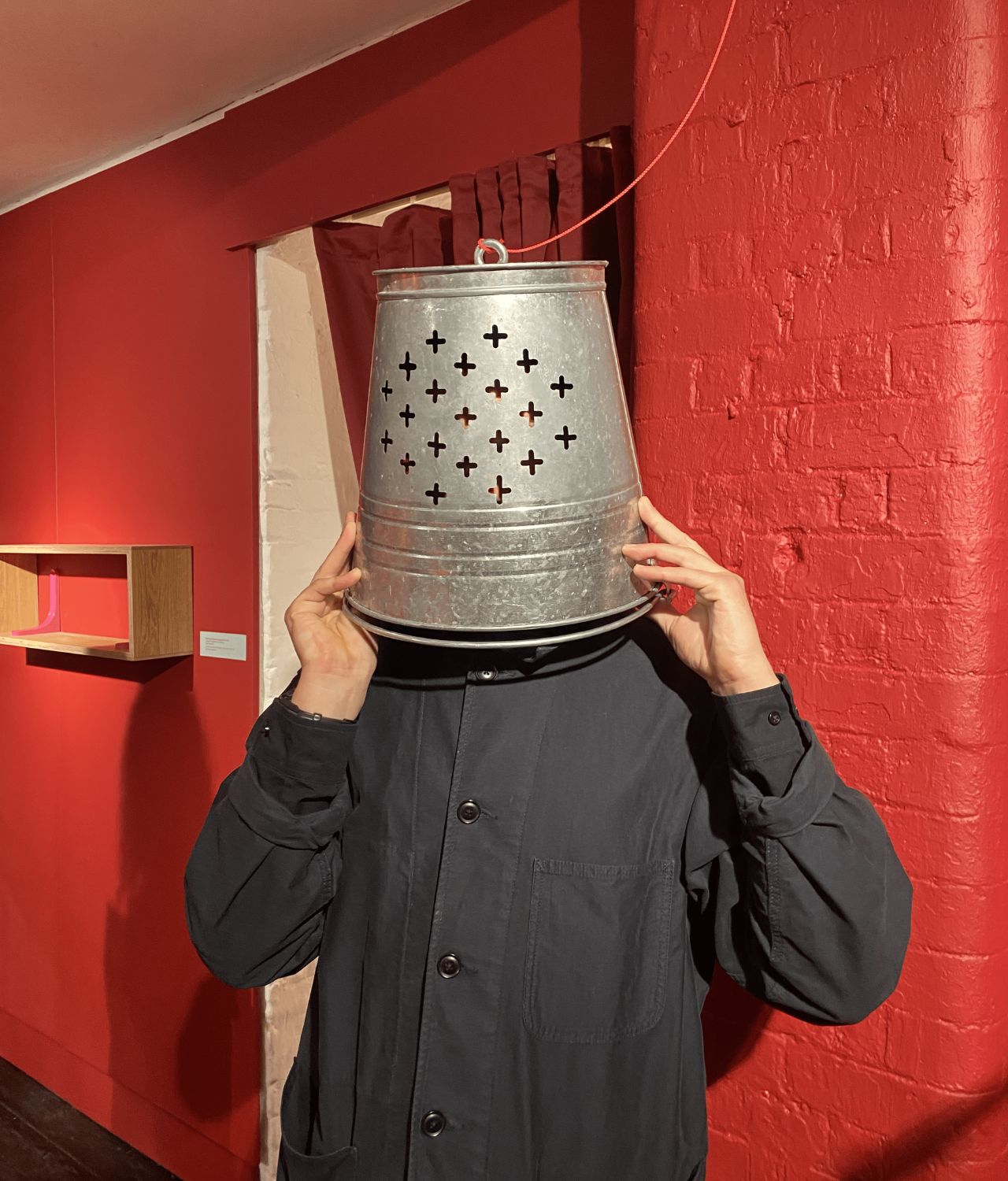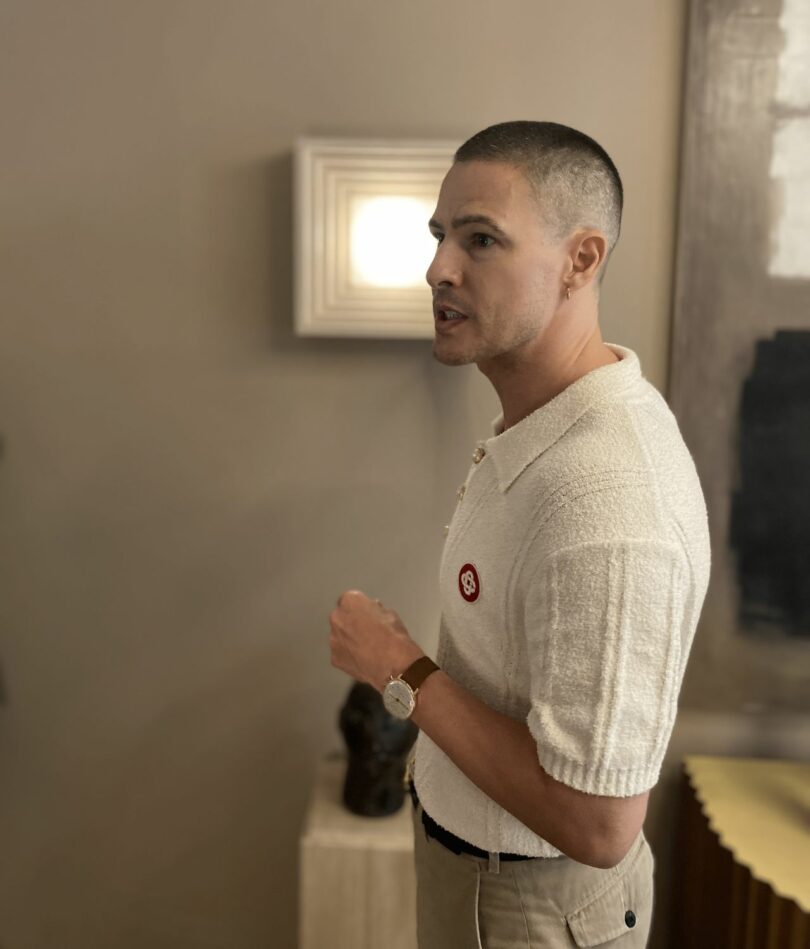
Shoreditch Design Triangle was established in 2008 to celebrate the creative industries in East London, and is hosted by the companies who live and work there. “Blending together product launches, exhibitions, installations, workshops, talks, tours, and culinary delights – the event gives visitors the opportunity to spend the day wandering around the East End on foot and still not see everything there is to see,” say the organizers. I did my best…!
Dan Tobin Smith’s Letter C – Collapse (above) is a new piece as part of his ongoing Alphabetical Series. “Inspired by the Bell inequality test, Dirac’s three polarizers experiment with the hidden nature of materials and perception, the sculpture exploits the strange phenomenon of polarization and material,” he says. “The typographical form, concealed in plain sight, is then revealed by the materials’ previously unseen characteristics.”
Inside, a series of tiny models of playgrounds by Tobin’s Optical Arts Studio cast dynamic shadows as they spun alongside films and stills that found typographic forms within the playground structures.
Just down the road Lee Broom, who opened his Shoreditch showroom in 2010, has recently expanded by taking on the space next door. Design Milk has been following his career since day one, so it was wonderful to see this new expansion and to see so many of the pieces launched in Milan ’22.
New for LDF23, was the Chant Chandelier (above) inspired by the glass bricks often used in places of worship built in the 1970s in place of stained glass. Lee also said he designed the light to be looked at from underneath and wanted to evoke the feeling of looking up from a basement through a lightwell in the floor above.
B Corp-certified lighting brand Tala launched the Mantle Portable Lamp (shown above in cobalt blue), which comes apart so the bulb, battery, and interior circuitry can all be replaced. I love the use of portable lights for, not only outdoor spaces, but also indoor nooks where a trailing cable would be problematic.
Shoreditch stalwart SCP worked with Carl Clerkin and friends to bring some much-need levity to proceedings with its tongue-in-cheek Federation of Furniture Fanciers SCPeep Show hosted by the Closed Curtain Club which riffed on Victorian sensibilities around the female form, but applied to furniture and accessories. The Doorknob Feeler Theatre (above) invited visitors to “have a good feel” of this cast aluminum Jasper Morrison FSB Doorknob.
The Confession Bucket by Poppy Booth is made of galvanized steel with confession grill holes and invited visitors to “pull bucket over head and confess, release slowly after use.” Its gentle and silly humor was so very welcome as LDF returns to form after some very serious world events.
On a more sensible note, SCP was also presenting a new collection of WonderGlass pieces by British architect and designer John Pawson including Berg, a glass coffee table that creates mesmerizing shadows underneath.
Carl Clerkin was also presenting Sons of Beasley with designer and colleague Alex Hellum. Alongside a new collection of chairs, there was a fully equipped live workshop where Carl, Alex, and friends were be making things by hand from offcuts, components, and materials donated by local cabinet maker Plykea – makers of door fronts and worktops for IKEA kitchens.
Upstairs SCP was showcasing its new foam-free method of upholstering furniture that comprises all natural materials including burlap, latex, and coconut fibers, recycled wool, latex, needled wool, multi-density wool, feathers, solid beech, birch and poplar plywood, webbing, and metal springs – upholstery foam is horrible for both the environment and the people who make, work with and use it, so this is a really important development.
This approach is now used across all of SCP’s sofas – including the low-lying Peonia by Wilkinson & Riveria, which they describe as a “family and friends sized sitting space.”
Element by Philippe Malouin is a modular “sofa system” that can be arranged perfectly traditionally, or into this playful “enclosed conversation pit” for the “ultimate comfort, conversation, and conviviality.”
If SCP is a Shoreditch Design Triangle stalwart, The Collective is the new kid in town. Designed by Studio Cass, its new Charlotte Road home is housed in a former button factory, and instead of looking like a showroom comprising a series of spaces – a kitchen, a bar, meeting rooms – that enable it to showcase the products, expertise, and quality behind The Collective and its associated brands.
One of those brands is EchoPanel® – acoustic panels made from PET offcuts – and even as the drinks started flowing and the evening’s party moved into full swing, the quality of sound in the space was palpable.
































